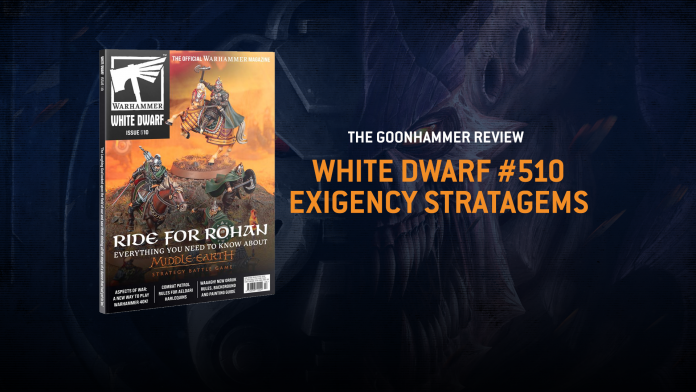This month’s White Dwarf includes new rules for a new way to play Warhammer 40k 10th edition, introducing Exigence Command Points. As always, we’ve read the rules over and have thoughts on how they’ll play and how they might be used in your games.
Exigence Command Points
Exigence Command points are designed to represent missions where extra resources have been committed due to unusually high stakes. These might best be used to represent a last-ditch effort or the final game in a campaign. If you’re using these rules, you cannot spend your Command Points on Core Stratagems – you can only use them on Stratagems from a Detachment or the Exigency Stratagems.
At the start of each Command phase, each player gains an Exigence Command Point (ECP) in addition to their regular Command point. These can only be spent on Exigency Stratagems.
Underdog Bonus
Starting in Battle Round 2, at the start of the round, if a player as at least 5 VP less than their opponent, they gain 1 ECP. If they have 15 VP less, they get an extra 1 CP. This replaces the Underdog bonus in Cauldron of War games, and you can still use those Core Stratagems if you’re playing Cauldron.
Strategic Reserves
In Exigence Games you can put up to 1,000 points of your army into Strategic Reserves in a Strike Force game, or 500 in Combat Patrol and 1,500 in Onslaught.
Exigency Stratagems
Now we get to the Stratagems. You can spend ECP and CP on these.
- Victory or Death (2ECP) – Used in the Fight phase to Automatically fight on death with a unit.
- Hammer Blow (2ECP) – Used in your Shooting phase or the Fight phase to give a unit +1 to hit, +1 to wound, and it can ignore any modifiers to AP and Damage on its attacks.
- Break the Line (1ECP) – Used in your Movement phase to add 2D6 to the Movement of a Mounted or Beast unit and when doing so it can move within Engagement Range of enemy units.
- Crushing Advance (1ECP) – Used in your Movement phase to let a TITANIC unit move an extra D6″ and also through enemy models, doing mortal wounds as it does so (pick an enemy unit you move across and roll 6D6, dealing mortals for each 3+).
- Targeted Demolition (1ECP) – Used in your Movement phase to give a Monster or Vehicle the ability to do mortal wounds to enemy models in an Area Terrain feature if you end their move within 2″ of it (roll a D6 for each enemy model in the feature, with +1 if they have T6+. On a 6+ that model’s unit takes a mortal wound, to a max of 6 per unit).
- Inescapable Augury (2ECP) – Used in your Shooting phase to give a unit’s ranged weapons Indirect Fire, but it reduces their range to 12″ and they can use Enhanced Ammunition in the same phase.
- Enhanced Ammunition (1ECP) – Used in your Shooting phase to give a unit +12″ range on their ranged weapons, or +6″ if they’re TORRENT weapons instead. You can’t combine this and Inescapable Augury.
- Valorous Charge (1ECP) – Used in your Charge phase to increase the range of a unit’s charge targeting to 18″, and they roll 3D6 when charging instead of 2D6.
- Hit the Deck (2ECP) – Used at the start of your opponent’s Shooting phase to give a unit of Infantry, Beasts, or Swarm the Stealth Ability and they can’t be targeted if they’re more than 18″ away.
- Interception (2ECP) – Used at the end of your opponent’s Charge phase to declare a charge with a unit that isn’t in Engagement range, but it doesn’t get the charge bonus, i.e. Fights First, this turn.
These are absolutely bonkers. Our initial thought when reading these was that they’d be really great if you were sick of your games making it all the way to battle round 4. These are wildly powerful effects, and as universal effects they give armies access to effects they never should have had. Being able to ignore damage and AP modifiers is very nasty, and with the exception of Hit the Deck, these all generally serve to make the game faster and deadlier. Being able to charge 18″ (with an average result of 10.5″ on 3D6 and much less variance on three dice) makes charging out of reserves/deep strike even more likely, and being able to fire any unit indirect at any time, or with +1 to hit and wound is just bonkers.
If you’re using these rules, you want to make sure you’re using the latest rules updates and dataslate so you can at least avoid the problem of Indirect torrent weapons blasting units through walls.
Ultimately I don’t think I’d play with these very often but I do like them for larger games and big important campaign-ending games, where you may have higher point values or more players. In those games having deadlier play is generally a good thing as it means you’ll be pulling more units off the table more quickly, speeding games up when they need it most. It’s an interesting set of rules and you definitely lose the nuance of a lot of the game’s more defensive stratagems without Smokescreen, Go to Ground, Heroic Intervention, and Counterattack. What you’re left with feels much more offensive and desperate, so kudos to the writer on these for capturing that feel. On the other hand, that may make for games where going first is a huge advantage.
Have any questions or feedback? Drop us a note in the comments below or email us at contact@goonhammer.com. Want articles like this linked in your inbox every Monday morning? Sign up for our newsletter. And don’t forget that you can support us on Patreon for backer rewards like early video content, Administratum access, an ad-free experience on our website and more.


